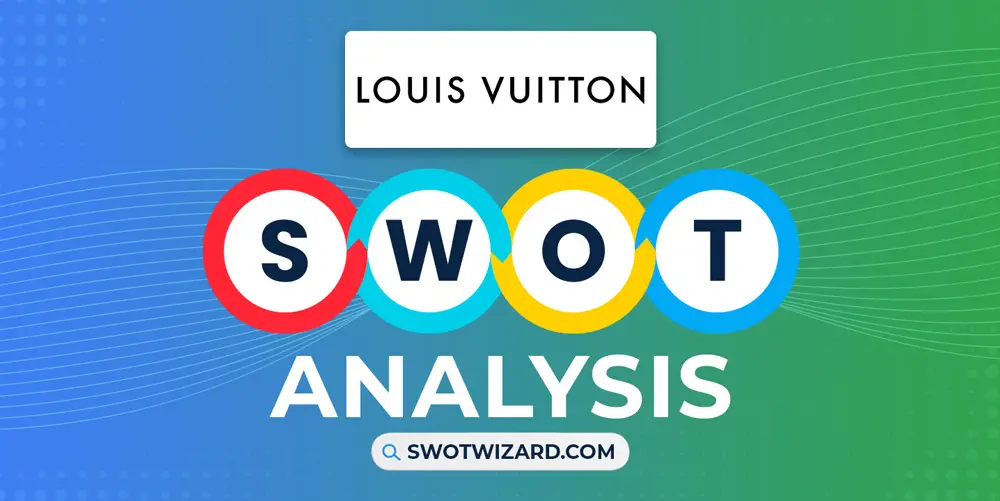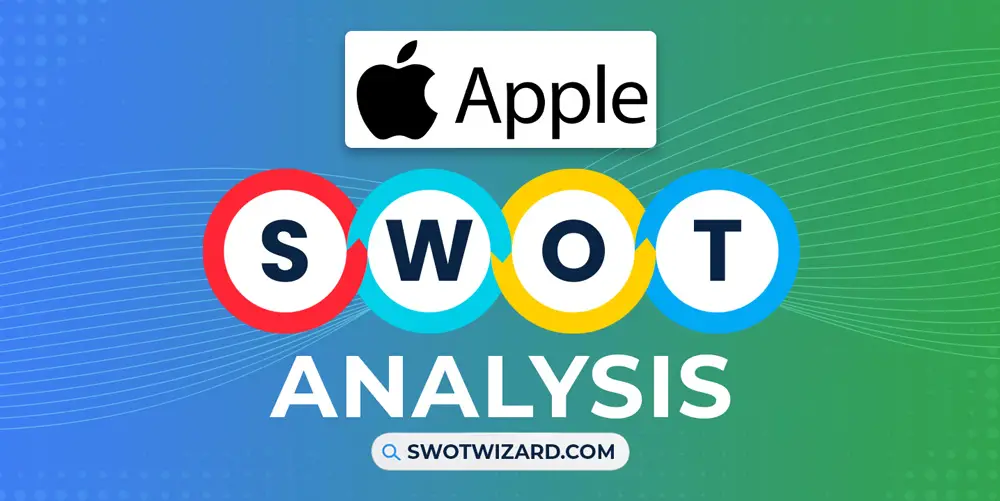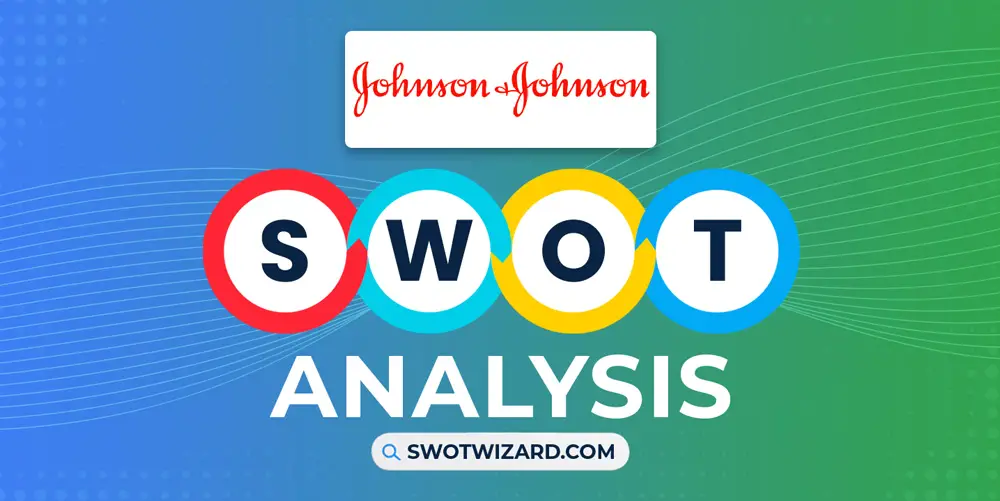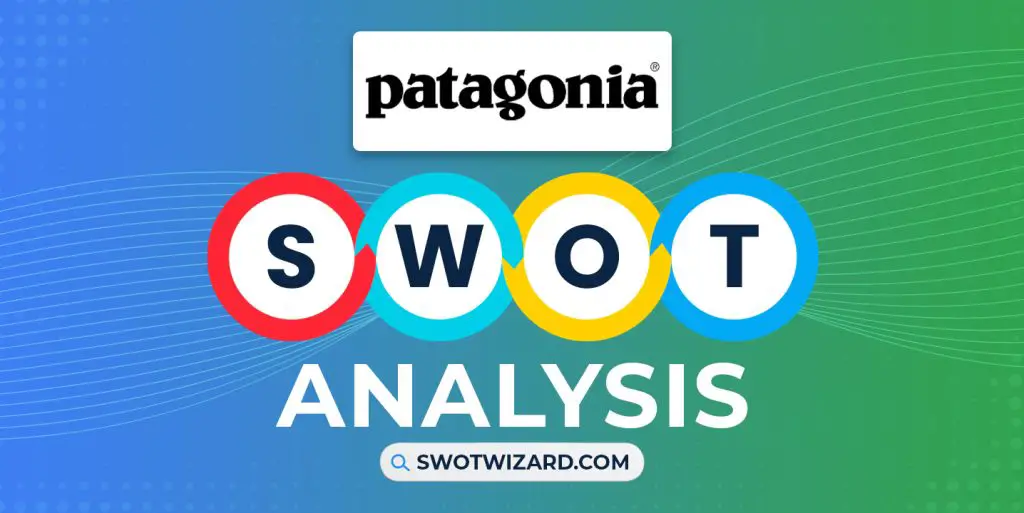Louis Vuitton is one of those names you know despite where you live because it is a world-known and represents luxury. Being one of the oldest luxury fashion houses worldwide, it has a long history in the industry with many strengths, weaknesses, opportunities, and threats, which we will get to know in this Louis Vuitton swot analysis.
Louis Vuitton: Company Overview
| Company | Louis Vuitton |
| Industry | Fashion |
| Founded | 1854 |
| Founder | Louis Vuitton |
| CEO | Pietro Beccari |
| Headquarter | Washington, U.S. |
| No. of Employees | 19,000+ |
| Annual Revenue | €14 billion (FY 2020) |
| Website | louisvuitton.com |
Before Louis Vuitton became a renowned fashion brand, its founder, Louis Vuitton, started his career as a trunk-maker for the elite. After gaining years of experience, he went on to found one of the oldest luxury fashion houses in the world, Louis Vuitton, in 1854.
Because of excellent craftsmanship and innovative designs, the company quickly gained recognition and expanded its product range. The company has a presence in over 50 countries with 460 stores and generated revenue of €79.2 B in 2022 with 196,006 employees.
Product & Services of Louis Vuitton
Handbags | Accessories | Ready-to-wear | Shoes | Watches | Jewelry
Louis Vuitton Competitors
Hermes | Gucci | Prada | Chanel | Burberry | Coach | Fendi | Versace | Dolce & Gabbana | Michael Kors
Did You Know?
Louis Vuitton introduced a new type of leather called Epi, which was a departure from the brand’s traditional monogram canvas in 1985, and it became an instant success, offering customers an alternative to the iconic monogram.
Strengths – Louis Vuitton SWOT Analysis
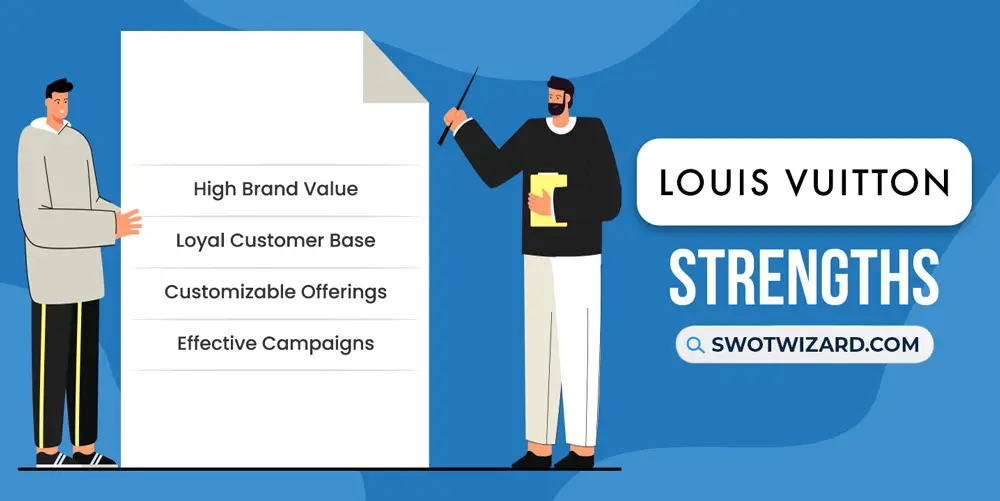
High Brand Value: The brand’s heritage, iconic monogram, and commitment to quality have established it as a symbol of prestige and exclusivity. As a result, Louis Vuitton enjoys an exceptional brand reputation, synonymous with luxury and craftsmanship. The latest data shows that the company’s brand value stood at $23.4B in 2022.
Loyal Customer Base: Loyalty is evident in the brand’s consistent sales growth and high customer retention rates. Louis Vuitton has cultivated a loyal customer base over the years. Its customers are devoted to the brand and view it as a status symbol. According to Consumer Affairs, the company has excellent customer service, which helped the company retain a loyal customer base.
Customizable Offerings: The brand offers monogramming services on its leather goods, enabling customers to add their initials or unique designs, enhancing the exclusivity and individuality of their purchases. Not just that, Louis Vuitton offers customizable options, allowing customers to personalize their products.
Effective Campaigns: There are dozens of luxury brands worldwide, but LV is the only company that has made the top 10 most valuable companies worldwide because it has a history of successful marketing campaigns that resonate with its target audience. Besides, collaborations with artists and celebrities have generated significant buzz and excitement, attracting existing and new customers.
Weaknesses – Louis Vuitton SWOT Analysis
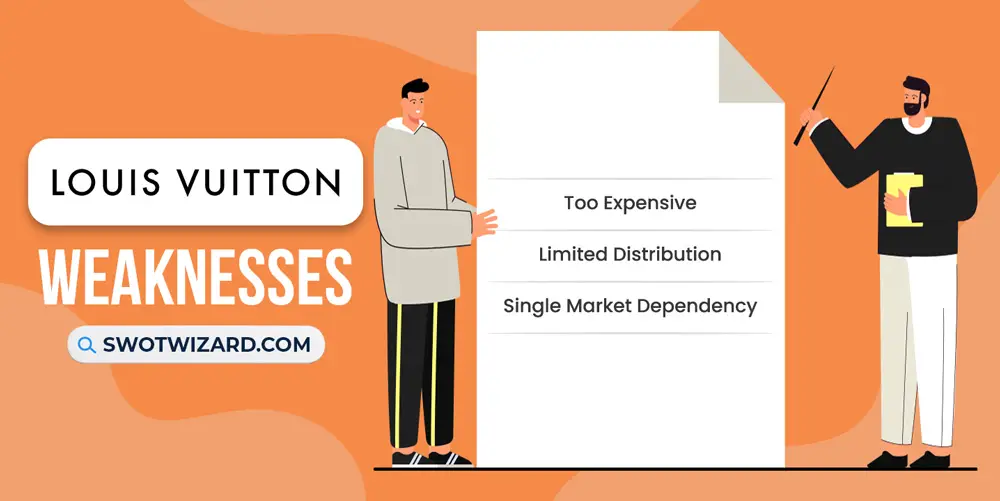
Too Expensive: As a luxury brand, it is perceived that its products will be more priced, and it’s justified. But, their high price point can limit accessibility to a broader customer base. Even their lowest product price starts from $1,290, which is still expensive and unaffordable for many consumers.
Limited Distribution: The company is strictly against counterfeit products, and as a part of the process, they have limited distribution. It maintains a selective distribution strategy, primarily selling its products through its boutiques and a limited number of high-end department stores. As a result, it can restrict market reach and availability, potentially missing out on potential customers.
Single Market Dependency: While Louis Vuitton has a global presence, it heavily relies on the luxury market, which can be susceptible to economic downturns or fluctuations. Besides, almost 63% of its revenue comes from specific markets like Europe, America, and Asia. As a result, the dependency can affect the overall revenue during recessions or other economic and supply chain issues.
Opportunities – Louis Vuitton SWOT Analysis

Market Expansion: There are enough opportunities, such as geographic expansion into emerging markets like China and India, where the demand for luxury goods is growing rapidly. Besides, collaborations with local designers or influencers cater to specific regional tastes and preferences, enhancing brand relevance and market penetration.
Target Diversification: The world is changing, as are the fashion trends and its customer base. It is time to expand product lines to target younger demographics, such as millennials and Gen Z, by introducing contemporary and streetwear-inspired collections. Even though they have a personalization offering, they can expand that line as well to capture niche markets within the luxury sector.
Digitalization: As the brand doesn’t have an international presence, it can enhance the e-commerce platform with immersive online experiences, virtual try-on technologies, and seamless mobile shopping apps. Besides, they can leverage social media platforms for brand engagement, influencer partnerships, and targeted digital marketing campaigns.
Sustainable Offerings: The demand for sustainable fashion is rising, and LV can utilize this by introducing sustainable materials and production methods, such as eco-friendly fabrics, organic leather, and responsible sourcing of raw materials. Additionally, there are also opportunities for setting up recycling and upcycling product programs, promoting circular economy practices.
Threats – Louis Vuitton SWOT Analysis
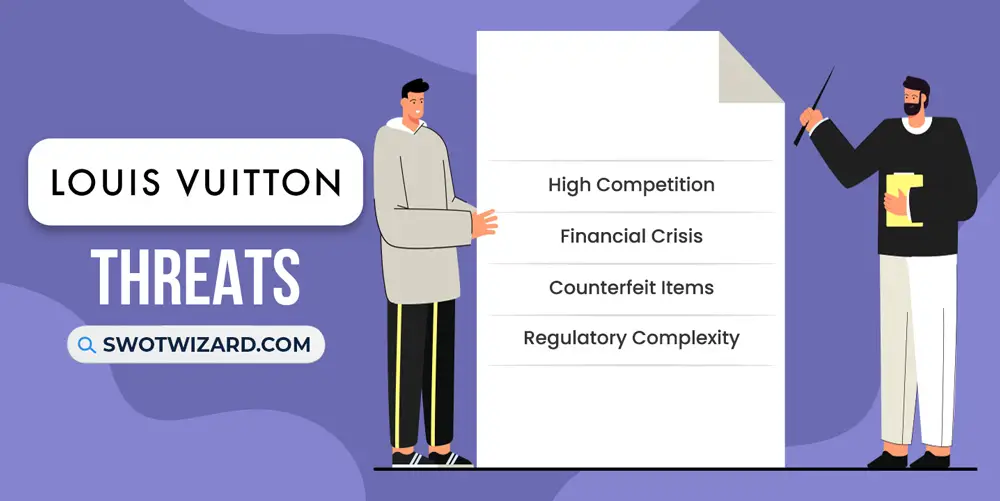
High Competition: The problem with luxury brands is they all have strong brand recognition, loyal customer bases, and offer similar high-quality products. And, being a luxury brand, LV faces intense competition from Gucci, Chanel, and other luxury brands. As a result, increasing revenue and market share is difficult.
Financial Crisis: During the global financial crisis 2008-2009, luxury brands experienced a decline in sales and lost around 10% market value as consumers became more cautious with their spending. In a time like 2023, where there are huge possibilities for the potential for a massive economic recession, the industry is again in danger.
Counterfeit Items: Counterfeit goods dilute the brand’s exclusivity and result in revenue loss and potential damage to the brand’s reputation. And, as a brand in this industry, Louis Vuitton items are plagued by counterfeit products. And there is an ongoing investigation in China for selling fake LV items in huge amounts.
Regulatory Complexity: Compliance with import/export regulations, intellectual property laws, and labor regulations can be complex and time-consuming as the company operates in over 50 countries. As the trade battle is rising globally, things are more complicated than ever.
[Bonus Infographic] SWOT Analysis of Louis Vuitton
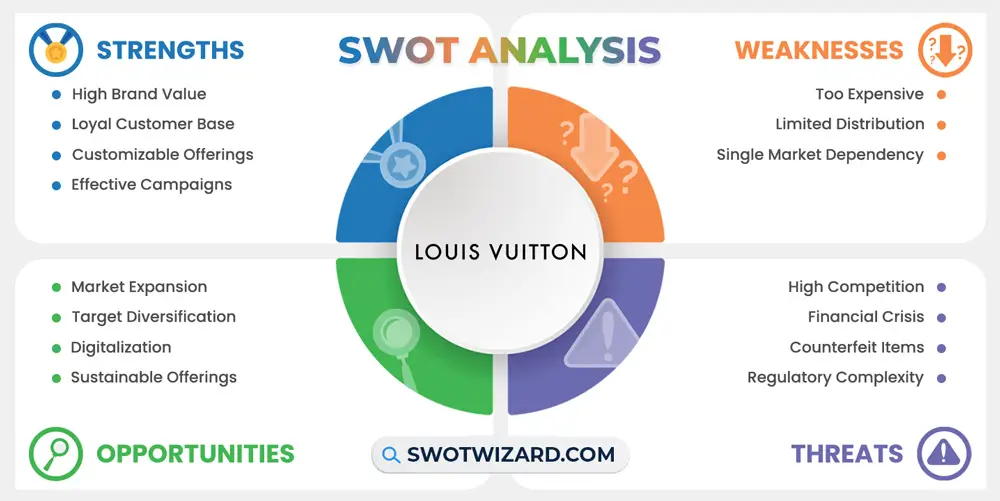
Recommendations for Louis Vuitton
For the coming economic downturns and to compete with all the giant competitors, here are some recommendations for the company.
- LV should consider diversifying its target groups to reduce dependence on a specific demographic.
- The company should continue exploring opportunities for market expansion.
- Embracing digital technologies and investing in e-commerce capabilities is crucial for Louis Vuitton’s future success.
- There is significant demand for sustainable offerings, and they should prioritize developing them.
- Strengthening anti-counterfeiting measures, such as advanced product authentication technologies, can help protect the brand’s intellectual property.
Frequently Asked Questions (FAQs)
Does BTS Wear Louis Vuitton?
Yes, BTS wears Louis Vuitton.
Does Louis Vuitton own Gucci?
No, Louis Vuitton doesn’t own Gucci, but it has a certain amount of stake in the ownership.
Final Words on Louis Vuitton SWOT Analysis
Louis Vuitton is a globally recognized luxury fashion brand with a rich history and a commitment to craftsmanship and innovation. Despite threats such as high competition, counterfeit items, and regulatory complexities, the brand’s market expansion, diversification efforts, digitalization, sustainable offerings, and anti-counterfeiting measures position it well for continued success and leadership in the luxury fashion industry.
References
- Wikipedia contributors. (n.d.). Louis Vuitton. Wikipedia.
- Socha, M. (2022, December 19). Louis Vuitton Goes Big With Yayoi Kusama Collaboration. WWD.
- Franz, M. (2022). Rita Chraibi and Louis Vuitton Collaboration With 111 West 57th Street. DOWNTOWN MAGAZINE.
- LVMH’s Louis Vuitton launches e-commerce website in China. (2017, July 21). FashionNetwork.com.
- Zhang, T. (2022, May 23). Louis Vuitton Investigates Counterfeit Selling Allegations in China. Yahoo.

